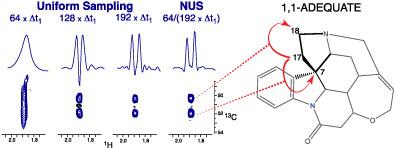当前位置:
X-MOL 学术
›
Magn. Reson. Chem.
›
论文详情
Our official English website, www.x-mol.net, welcomes your
feedback! (Note: you will need to create a separate account there.)
Developing Nonuniform Sampling Strategies to Improve Sensitivity and Resolution in 1,1-ADEQUATE Experiments
Magnetic Resonance in Chemistry ( IF 1.9 ) Pub Date : 2020-03-23 , DOI: 10.1002/mrc.4995 Mark S Roginkin 1 , Ikenna E Ndukwe 2, 3 , D Levi Craft 1 , R Thomas Williamson 2, 4 , Mikhail Reibarkh 2 , Gary E Martin 2, 5 , David Rovnyak 1
Magnetic Resonance in Chemistry ( IF 1.9 ) Pub Date : 2020-03-23 , DOI: 10.1002/mrc.4995 Mark S Roginkin 1 , Ikenna E Ndukwe 2, 3 , D Levi Craft 1 , R Thomas Williamson 2, 4 , Mikhail Reibarkh 2 , Gary E Martin 2, 5 , David Rovnyak 1
Affiliation

|
Nonuniform sampling (NUS) strategies are developed for acquiring highly resolved 1,1‐ADEQUATE spectra, in both conventional and homodecoupled (HD) variants with improved sensitivity. Specifically, the quantile‐directed and Poisson gap methods were critically compared for distributing the samples nonuniformly, and the quantile schedules were further optimized for weighting. Both maximum entropy and iterative soft thresholding spectral estimation algorithms were evaluated. All NUS approaches were robust when the degree of data reduction is moderate, on the order of a 50% reduction of sampling points. Further sampling reduction by NUS is facilitated by using weighted schedules designed by the quantile method, which also suppresses sampling noise well. Seed independence and the ability to specify the sample weighting in quantile scheduling are important in optimizing NUS for 1,1‐ADEQUATE data acquisition. Using NUS yields an improvement in sensitivity, while also making longer evolution times accessible that would be difficult or impractical to attain by uniform sampling. Theoretical predictions for the sensitivity enhancements in these experiments are in the range of 5–20%; NUS is shown to disambiguate weak signals, reveal some nJCC correlations obscured by noise, and improve signal strength relative to uniform sampling in the same experimental time. This work presents sample schedule development for applying NUS to challenging experiments. The schedules developed here are made available for general use and should facilitate the broader utilization of ADEQUATE experiments (including 1,1‐, 1,n‐, and HD‐ variants) for challenging structure elucidation problems.
中文翻译:

开发非均匀采样策略以提高 1,1-充分实验的灵敏度和分辨率
非均匀采样 (NUS) 策略被开发用于获取高分辨率的 1,1-充分光谱,在传统和同模式耦合 (HD) 变体中具有更高的灵敏度。具体来说,分位数定向方法和泊松间隙方法在样本分布不均匀方面进行了严格比较,并且分位数时间表进一步优化了加权。评估了最大熵和迭代软阈值谱估计算法。当数据减少程度适中时,所有 NUS 方法都是稳健的,大约减少 50% 的采样点。通过使用分位数方法设计的加权计划,可以促进 NUS 进一步减少采样,这也很好地抑制了采样噪声。种子独立性和在分位数调度中指定样本权重的能力对于优化 NUS 以获取 1,1-ADEQUATE 数据很重要。使用 NUS 可以提高灵敏度,同时还可以实现更长的进化时间,这是通过统一采样难以或不切实际的。这些实验中灵敏度增强的理论预测在 5-20% 的范围内;显示 NUS 可以消除弱信号的歧义,揭示一些被噪声掩盖的 nJCC 相关性,并在相同的实验时间内提高相对于均匀采样的信号强度。这项工作提出了将 NUS 应用于具有挑战性的实验的样本计划开发。此处制定的时间表可供一般使用,并应促进 ADEQUATE 实验(包括 1,1-、1,n-、
更新日期:2020-03-23
中文翻译:

开发非均匀采样策略以提高 1,1-充分实验的灵敏度和分辨率
非均匀采样 (NUS) 策略被开发用于获取高分辨率的 1,1-充分光谱,在传统和同模式耦合 (HD) 变体中具有更高的灵敏度。具体来说,分位数定向方法和泊松间隙方法在样本分布不均匀方面进行了严格比较,并且分位数时间表进一步优化了加权。评估了最大熵和迭代软阈值谱估计算法。当数据减少程度适中时,所有 NUS 方法都是稳健的,大约减少 50% 的采样点。通过使用分位数方法设计的加权计划,可以促进 NUS 进一步减少采样,这也很好地抑制了采样噪声。种子独立性和在分位数调度中指定样本权重的能力对于优化 NUS 以获取 1,1-ADEQUATE 数据很重要。使用 NUS 可以提高灵敏度,同时还可以实现更长的进化时间,这是通过统一采样难以或不切实际的。这些实验中灵敏度增强的理论预测在 5-20% 的范围内;显示 NUS 可以消除弱信号的歧义,揭示一些被噪声掩盖的 nJCC 相关性,并在相同的实验时间内提高相对于均匀采样的信号强度。这项工作提出了将 NUS 应用于具有挑战性的实验的样本计划开发。此处制定的时间表可供一般使用,并应促进 ADEQUATE 实验(包括 1,1-、1,n-、











































 京公网安备 11010802027423号
京公网安备 11010802027423号